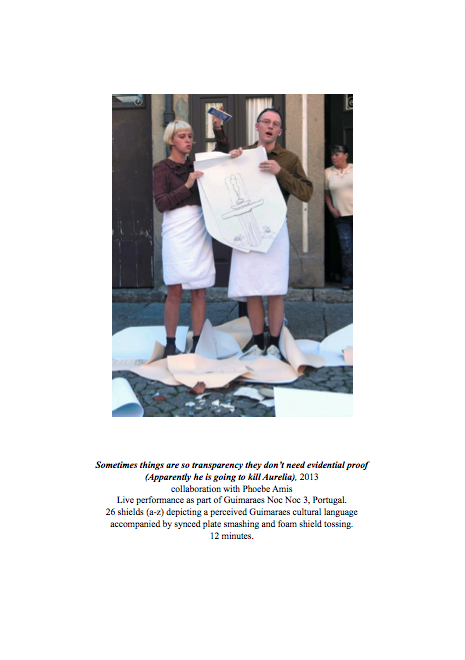A big part of assembling the archive was debating what or was not performance, and what or was not a performance document.
I am conscious of how much I think about performance art beyond the confines of the live event; or in another way, how the live event can extend to include all organisational, social, and logistical work towards enabling an action to take place.
I believe that a definition of performance should not only constitute the performed ‘other’ subjectivity in duality with a live audience who encounter it; but should include the (il)logic(al) personality that plays out as it negotiates access, garners trust, and does irrationality. Performance is an altered state of being that re-organises reality to engender new decision-making capacities. This is both powerful in its ability to produce and calcify an ideological norm, and dangerous for the same reasons. In performance art we see this when a chain of thought leads to the action where an unnamed friend of Chris Burden fires a rifle at him (Shoot, 1971). And outside of performance art… well, there has been too many instances of when a similar train of thought has lead to unspeakable acts of violence.
Within this definition, all kinds of adopted, and invented, systems of thought– economies, institutions, moralities, communities– are organised ways of conventionalising unreal patterns of thought that perpetually reproduce themselves through the performance of this thought. When we submit ourselves to collaborating with an organisation, we perform in two separate ways: 1) the inheritance of given values, and reproduction of these; and 2) the individuation of the self within a given set of freedoms. Both of these attitudes play within our new uncanny realms, and performance is exerted to sustain meaning within the construct at all costs. This performance defines this limit or surface to the object of the system.
Because of this, performance can never be evaluated or contained to a singular ‘deliverable outcome’, instead it is how we continuously and complicitly operate within a closed system.
The task of defining what is and what isn’t performance within this fluctuating terrain of expectations is difficult. Everything is content and evidence for a performativity; reviewed by it’s consistency to a socially-constructed norm. As a performance artist, I believe it’s important to understand these fabricated ethics, and the frictions they cause within existing modes of production.
But how is that documented?
Portfolios seem redundant in imaging this kind of performance. Artist Statements purely gesticulate without evidence. Bios are rhetorical and fantastica (reflective writing including this a-n blog is similar). CVs are too simple and mask irrationality (but at least they implicate partnerships). Cover Letters and Proposals are probably the closest to an appropriate form– brutally honest in the submissive potential of artistic labour.
Maybe what’s not important is the standardising and mapping of a muliplicitous array of decisions, and their contextual drives, but the register in which these are communicated, the style through which we build personality. In each of the formats from above we can direct our attention to the evolving format of the document rather than the accumulating narrative picture. What we might see is: the variations in font-size; the typeface shifting from serif to sans serif; an encroaching margin-size; thickness of the borders to images. These micro-variations in how the proposal adapts its register to suit a request for support might actually be much more telling than imaginary portfolio. Can these remaining submissive-impressions provide a truer document or portfolio for social-performative practice?



